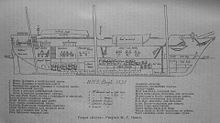 Longitudinal section of HMS Beagle (Cherokee class) as of 1832, by then converted to a barque by addition of a mizzen-mast.
| |
| Class overview | |
|---|---|
| Name | Cherokee-class brig-sloop |
| Operators | |
| Planned | 115 |
| Completed |
|
| Cancelled | 11 |
| General characteristics | |
| Type | Brig-sloop |
| Tons burthen | 238 bm |
| Length |
|
| Beam | 24 ft 6 in (7.47 m) |
| Draught | 12 ft 6 in (3.8 m) |
| Depth of hold | 11 ft 0 in (3.4 m) |
| Propulsion | Sails |
| Complement |
|
| Armament |
|
The Cherokee class was a class of brig-sloops of the Royal Navy, mounting ten guns. Brig-sloops were sloops-of-war with two masts (a fore mast and a taller main mast) rather than the three masts of ship sloops. Orders for 115 vessels were placed, including five which were cancelled and six for which the orders were replaced by ones for equivalent steam-powered paddle vessels.[1]
Many of these sailing vessels served as mail packet ships, and more than eight assisted with exploration and surveys. The best known of the class was HMS Beagle, then considerably modified for Beagle's second survey voyage under Robert FitzRoy, with the gentleman naturalist Charles Darwin on board as a self-funded supernumerary.[2][3]
- ^ "HMS Beagle – Port of science and discovery – Port Cities". Retrieved 30 January 2009.
- ^ Taylor 2008, pp. 36–38
- ^ FitzRoy 1839, pp. 17–22
